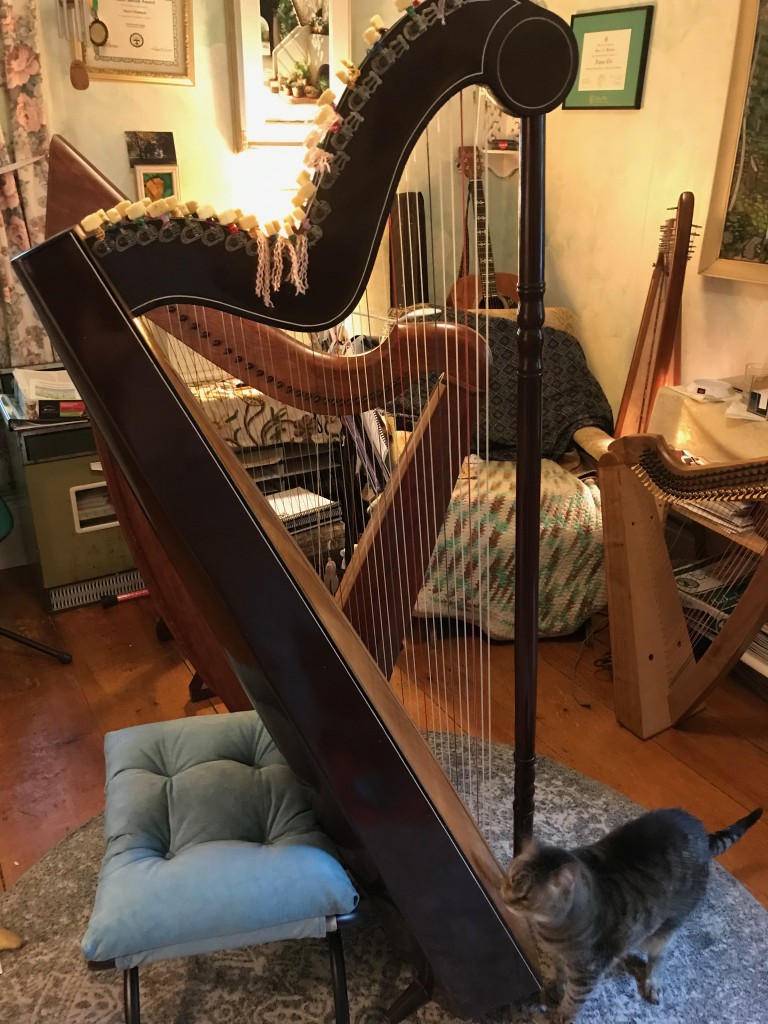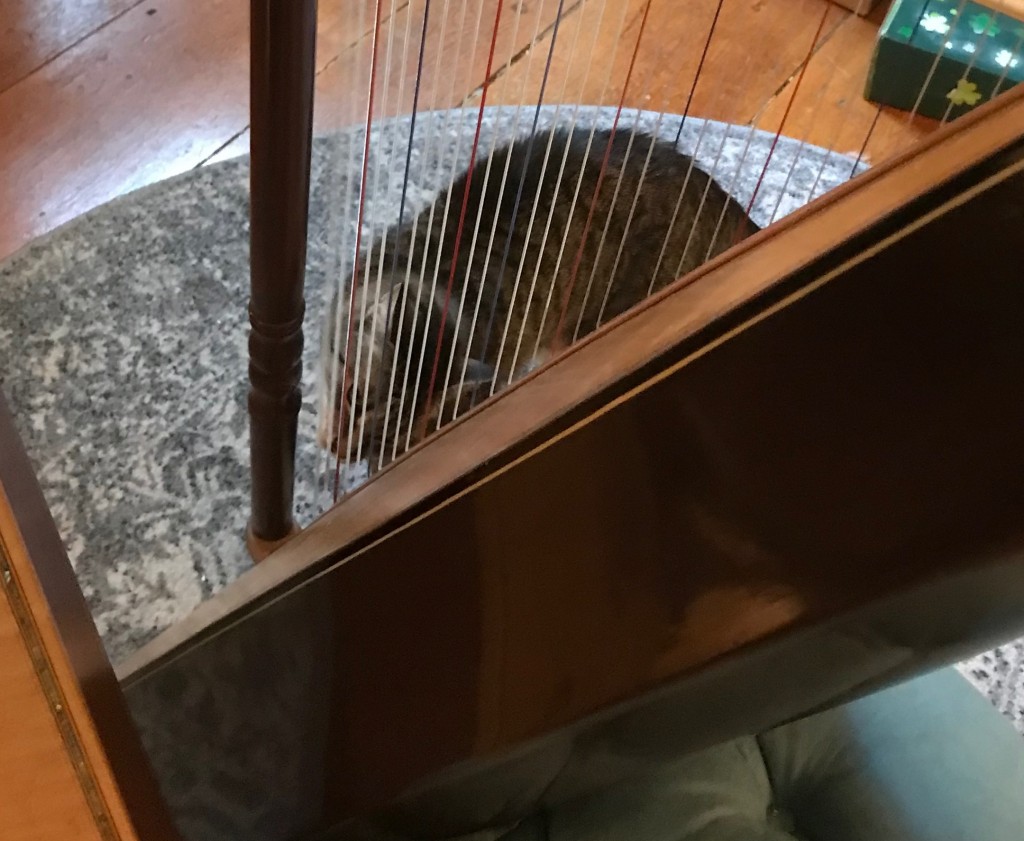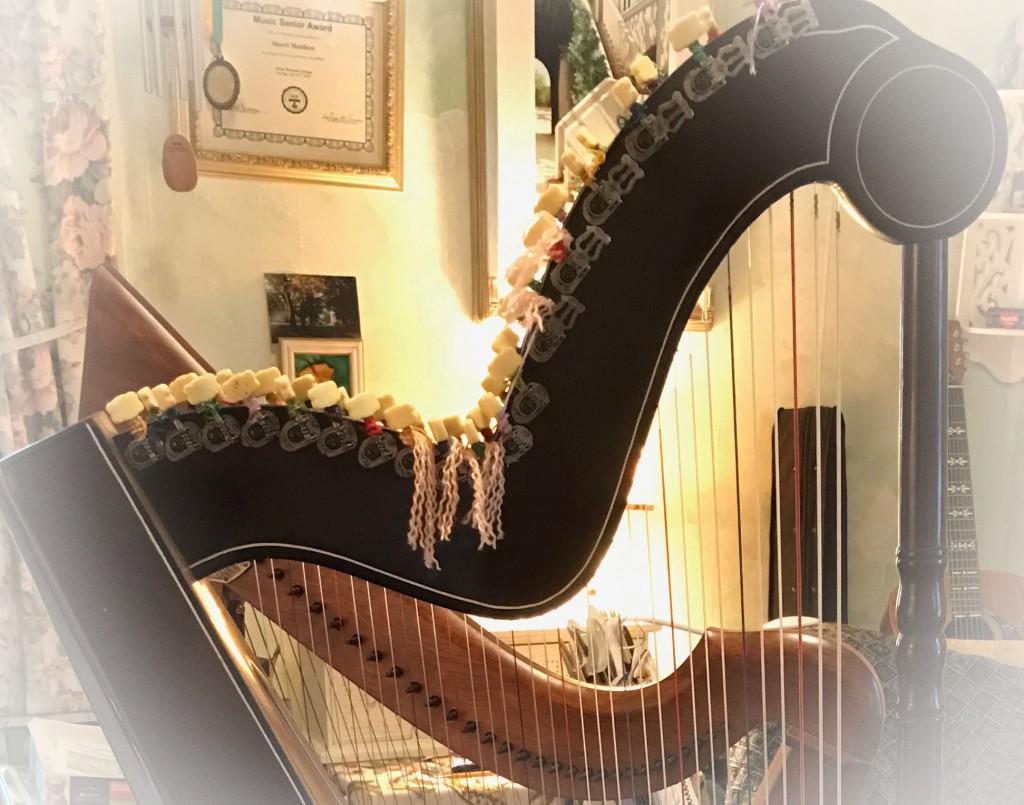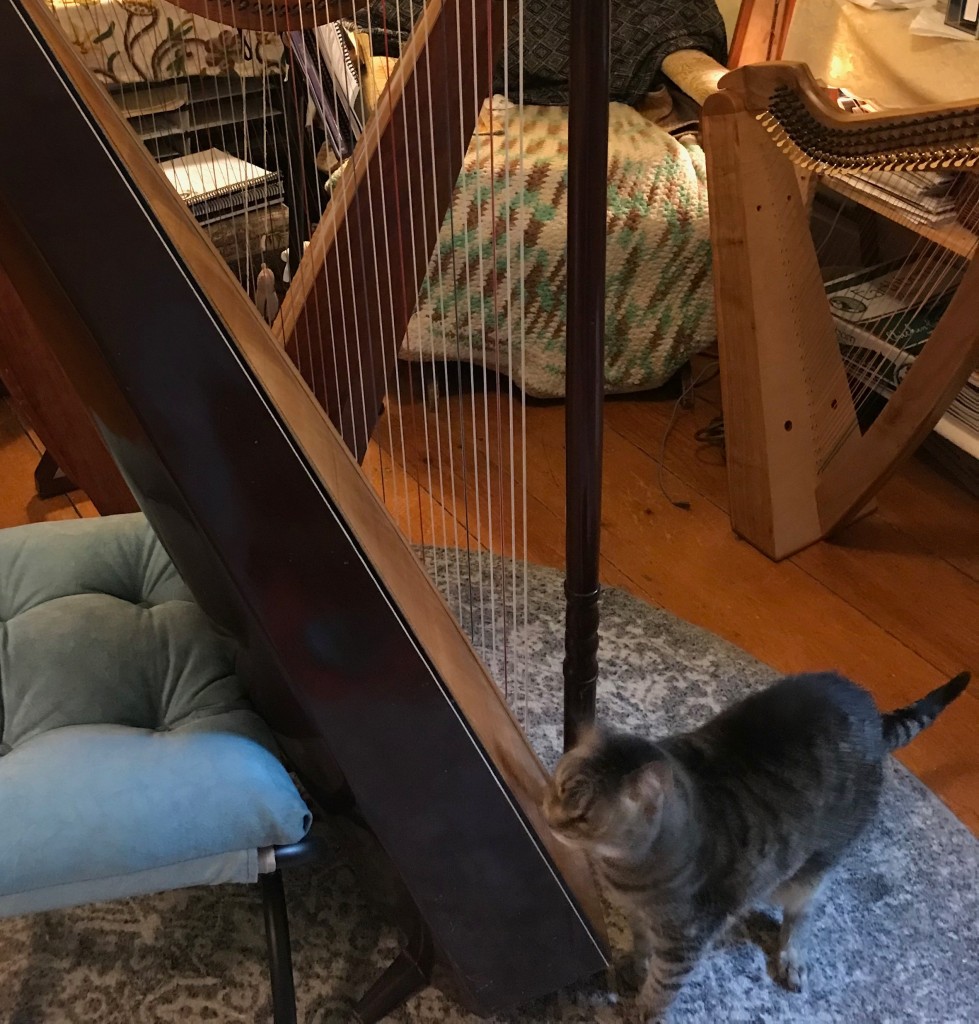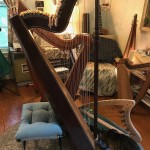 Here is my Paraguayan harp. It actually belongs to my husband George Matthew Jr., who bought it at a church fundraiser some years ago when he was living in CT. I’ve done some research on it and discovered it was built by Adelio Ovelar of Asunción, Paraguay sometime in the early 1980’s. It was my student harp before I acquired my first wire-strung harp, my Triplett Luna, in 2009.
Here is my Paraguayan harp. It actually belongs to my husband George Matthew Jr., who bought it at a church fundraiser some years ago when he was living in CT. I’ve done some research on it and discovered it was built by Adelio Ovelar of Asunción, Paraguay sometime in the early 1980’s. It was my student harp before I acquired my first wire-strung harp, my Triplett Luna, in 2009.
It has 36 nylon strings and a much lower tension than any of my wire harps. There are no sharping levers or blades. I do have a sharping ring that I’ve been learning to use, which is more traditional in Latin American countries since chromatics are not in as frequent use in their music as they are in Irish or folk music from the global north.
It’s a very lightweight harp. You can easily pick it up with hand. It literally feels as lightweight as a feather. In contrast, two of my wire harps are quite heavy.
I actually learned basic wire harp technique on this instrument before commissioning my Luna to be built, because I wasn’t sure at the time I could really be a harpist… I was still actively involved with pipe organ degree studies at the time. Now today with three very unique wire harps from different builders and solid playing technique, I feel I can go back and learn proper Paraguayan harp playing. To that end, I’ve been studying out of Dr. Alfredo Rolando Ortiz’s book: Latin American Harps: History, Music and Techniques for Pedal and Non-Pedal Harpists, 3rd ed.
I’ve also been re-learning Spanish! I’ve have had several classes in high school and college but my reading/writing/listening skills have slipped a little in recent years. I firmly believe this country is on the path to being bilingual in the future, as more Central and South American refugees make the U.S.A. their home, for both themselves and their children. Red and blue state politics aside, the future will be many more Spanish speakers here and I plan on being welcoming! No doubt at some point our church will be hosting visitors who may not be entirely fluent in English yet and it will be both courteous and helpful to be able to speak Spanish to our guests (and prospective new members).
I have plans for playing my Paraguayan harp in church some Sunday morning! In the meantime, I continue to study the instrument until I have my playing ability at a level I feel is suitably authentic and will make a nice prelude/postlude. And yes, it is tuned to A440 for those who were wondering… so we can do organ and harp duets!
What are the little tassels for, you ask? Because when I first got ahold of this harp, it desperately needed new strings. Some were broken, others were brittle and wouldn’t hold tune. I ordered a complete new set from Vermont Strings in Waterbury. It took me three days to install them, because the access port is on the bottom of the harp and there was no way to reach the topmost holes except slowly and painfully. Some of the strings I accidentally wound onto the guitar tuners backwards! Yes. Backwards. I was tired. So when you go to tune the harp, you need to know which ones those are, so you don’t accidentally crank the tuner in the wrong direction – high when you want to go down and vice versa. I made decorative tassels to indicate which ones those are. I probably could unwind the strings and make them go in the correct direction, but they love to drop into that middle V of the neck once you do that… and it can be a really challenge to fish them out of there. I’ve found crochet hooks are very useful in restringing this harp. (Which I have no plans to do again for a long time!)
You’ll notice Jasmine Kitty posing with the harp. She comes running whenever she knows I’m about to take harp photos… she has a sixth sense about these things and has to get into the shot some which way! So here’s a cropped photo of Jazzie playing a little:
Leer en Español:
Aqui esta mi arpa Paraguaya. En realidad, pertenece a mi esposo George Matthew Jr., quien lo compró en una recaudación de fondos de la iglesia hace algunos años cuando vivía en CT. Investigué un poco y descubrí que fue construido por Adelio Ovelar de Asunción, Paraguay, en algún momento a principios de la década de 1980. Fue mi arpa de estudiante antes de adquirir mi primer arpa con cuerdas de alambre, mi Triplett Luna, en 2009.
Tiene 36 cuerdas y una tensión mucho menor que cualquiera de mis arpas de alambre. No hay palancas de afilado o paletas. Sí tengo un taquito que he estado aprendiendo a usar, que es más tradicional en los países latinoamericanos ya que los cromatismos no se usan con tanta frecuencia en su música como en la música irlandesa o folklórica del norte global.
Es un arpa muy ligera. Puedes levantarlo fácilmente con una mano. Literalmente se siente tan ligero como una pluma. Por el contrario, dos de mis arpas de alambre son bastante pesadas.
De hecho, aprendí la técnica básica del arpa de alambre en este arpa antes de encargar la construcción de mi Luna, porque e ese momento no estaba seguro de poder ser un arpista… Todavía estaba activamente involucrado en los estudios de grado de órgano de tubos en ese momento. Ahora, con tres arpas de alambre muy singulares de diferentes constructores y una sólida técnica de ejecución, siento que puedo regresar y aprender a tocar correctamente el arpa paraguaya. Con ese fin, he estado estudiando el libro del Dr. Alfredo Rolando Ortiz: Arpas latinoamericanas: historia, música y técnicas para arpistas de pedal y sin pedal, 3ra ed.
¡También he estado re-aprendiendo español! He tenido varias clases en la escuela secundaria y la universidad, pero mis habilidades de lectura/escritura/escucha han disminuido un poco en los últimos años. Creo firmemente que este país está en camino de ser bilingüe en el futuro, a medida que más refugiados de América Central y del Sur hagan de los Estados Unidos su hogar, tanto para ellos como para sus hijos. Dejando a un lado la política estatal roja y azul, en el futuro habrá muchos más hispanohablantes aquí y ¡planeo ser bienvenido! Sin duda, en algún momento, nuestra iglesia recibirá a visitantes que quizás aún no hablen inglés con fluidez y será cortés y útil poder hablar español con nuestros invitados (y posibles nuevos miembros).
¡Tengo planes para tocar mi arpa paraguaya en la iglesia algún domingo por la mañana! Mientras tanto, sigo estudiando el instrumento hasta que tengo mi habilidad para tocar a un nivel que siento que es lo suficientemente auténtico y será un buen preludio/postludio.
Y sí, está afinado en A440 para aquellos que se preguntaban… ¡así que podemos hacer dúos de órgano y arpa!
¿Para qué son las pequeñas borlas, te preguntarás? Porque cuando conseguí este arpa por primera vez, necesitaba desesperadamente cuerdas nuevas. Algunos estaban rotos, otros eran quebradizos y no aguantaban la brea. Compré un juego completo nuevo de Vermont Strings en Waterbury. Me tomó tres días instalarlos, porque el puerto de acceso está en la parte inferior del arpa y no había forma de llegar a los agujeros superiores excepto lenta y dolorosamente. ¡Algunas de las cuerdas las enrollé accidentalmente en los afinadores de guitarra al revés! Sí. Hacia atrás. Estaba cansado. Entonces, cuando vas a afinar el arpa, necesitas saber cuáles son, para no girar accidentalmente el afinador en la dirección equivocada – alto cuando quiere bajar y viceversa. Hice borlas decorativas para indicar cuáles son. Probablemente podría desenrollar las cuerdas y hacer que vayan en la dirección correcta, pero les encanta caer en esa V central del mástil una vez que haces eso… y puede ser un verdadero desafío sacarlos de allí. Descubrí que los ganchillos de crochet son muy útiles para encordar este arpa. (¡Lo cual no tengo planes de volver a hacer durante mucho tiempo!)
Notarás a Jasmine Kitty posando con el arpa. Ella viene corriendo cada vez que sabe que estoy a punto de tomar fotos de arpa… ¡Ella tiene un sexto sentido para estas cosas y tiene que meterse en la foto de alguna manera! Así que aquí hay una foto recortada de Jazzie jugando un poco:

